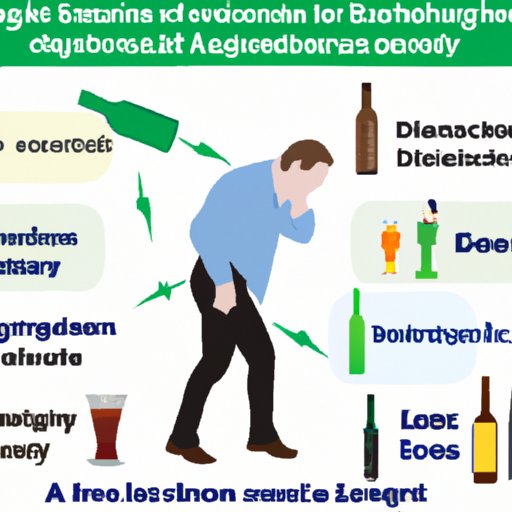Introduction
Alcohol intoxication is a phenomenon familiar to many people, but few understand the complex web of physical, mental and social factors that lead to it. This article will explore the various causes of alcohol intoxication, from the physical effects of alcohol on the body to the role of genetics, metabolism and social factors. By understanding the different components of alcohol intoxication, we can gain insight into how to prevent it.

Exploring the Physical Effects of Alcohol on the Body
When alcohol enters the body, it is quickly absorbed into the bloodstream, where it travels to the liver for processing. The liver is responsible for metabolizing, or breaking down, the alcohol so that it can be eliminated from the body. The liver can only process a certain amount of alcohol at a time, which means that the more alcohol you consume, the longer it takes to be processed and eliminated from the body.
The short-term physical effects of alcohol include impaired coordination, slurred speech, slowed reaction times, and decreased inhibitions. Long-term effects can range from liver damage to heart disease and even certain types of cancer. These physical effects of alcohol can have serious implications for anyone who chooses to drink.
How Does Alcohol Interact with the Brain to Produce Intoxication?
Alcohol affects the brain by altering the neurotransmitters, or chemicals, that carry signals between neurons. This disruption of communication between neurons leads to the impaired judgment and decision-making associated with alcohol intoxication. For example, alcohol can reduce inhibition, making it easier to engage in risky behaviors such as driving while intoxicated.
Studies have shown that alcohol consumption can also affect memory formation and recall. According to a study published in the journal Neuropsychopharmacology, “chronic alcohol consumption impairs the ability to form new memories and to recall old ones.” This effect can worsen with increased levels of intoxication.

Investigating the Role of Genetics in Alcohol Intoxication
Studies have found that certain individuals may have a genetic predisposition to alcohol intolerance, meaning that they are more likely to experience negative physical effects from drinking, such as nausea or dizziness. This genetic predisposition can vary from person to person, depending on a variety of factors, including gender, ethnicity, and family history.
In a study published in the journal Human Molecular Genetics, researchers identified several genes associated with alcohol tolerance, including genes involved in the production of enzymes that break down alcohol. These findings suggest that some individuals may be genetically predisposed to experiencing more severe intoxication when drinking alcohol.

Examining the Role of Metabolism in Alcohol Intoxication
Alcohol metabolism also plays an important role in alcohol intoxication. Metabolism refers to the process by which the body breaks down and eliminates alcohol from the body. Individuals who have slower rates of metabolism are more likely to experience greater levels of intoxication because the alcohol remains in their bodies for longer periods of time.
Factors such as age, gender, body size, and genetics can all affect alcohol metabolism. For example, women tend to have slower rates of alcohol metabolism than men, which can lead to higher levels of intoxication. Additionally, individuals with higher body weights tend to have slower rates of metabolism, which can also lead to increased levels of intoxication.
Understanding the Social Factors Contributing to Alcohol Intoxication
Social factors, such as peer pressure, cultural norms, and advertising, can also influence alcohol consumption and intoxication. Peer pressure can lead individuals to drink more than they normally would, while cultural norms around alcohol use can encourage excessive drinking. Advertising campaigns can also promote the idea that alcohol consumption is fun and desirable, thereby encouraging individuals to drink more than they should.
In addition, studies have found that individuals who are exposed to alcohol-related advertising are more likely to engage in heavy drinking. According to a study published in the journal Addiction, “exposure to alcohol advertising increases the likelihood of underage drinking, binge drinking and other problem drinking behaviours.”
Conclusion
Alcohol intoxication is a complex phenomenon that is influenced by a variety of physical, mental, and social factors. The physical effects of alcohol on the body can lead to impaired coordination and decision-making, while genetics and metabolism can affect an individual’s susceptibility to alcohol intoxication. Additionally, social factors, such as peer pressure and advertising, can influence alcohol consumption and increase the risk of intoxication.
By understanding the different components of alcohol intoxication, we can gain insight into how to prevent it. This includes avoiding situations that might lead to excessive drinking, such as peer pressure or alcohol advertising. Additionally, individuals should be aware of their own unique risk factors, such as genetics and metabolism, and take steps to reduce their risk of alcohol intoxication.
(Note: Is this article not meeting your expectations? Do you have knowledge or insights to share? Unlock new opportunities and expand your reach by joining our authors team. Click Registration to join us and share your expertise with our readers.)
